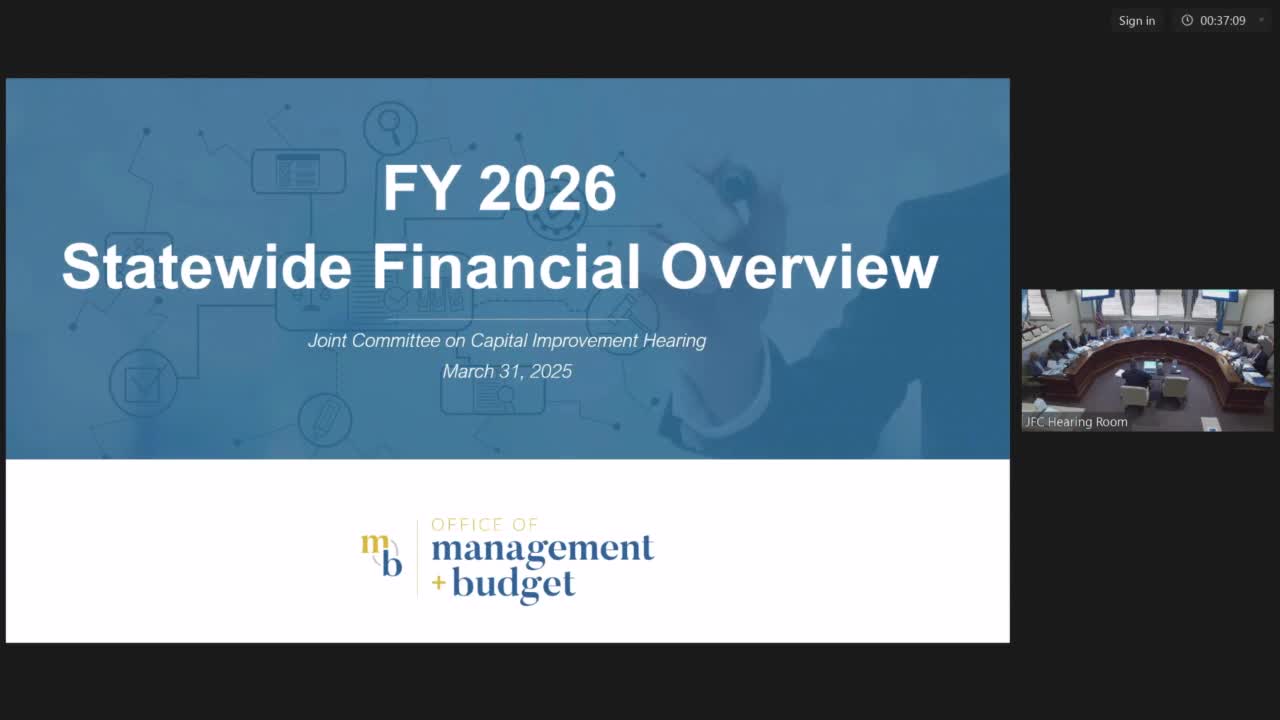State releases FY 2026 financial overview showing gap between budget growth and revenue projections
March 31, 2025 | 2025 Legislature DE Collection, Delaware
This article was created by AI summarizing key points discussed. AI makes mistakes, so for full details and context, please refer to the video of the full meeting. Please report any errors so we can fix them. Report an error »

Director Maxwell of the Office of Management and Budget delivered a statewide FY 2026 financial overview, telling the Joint Committee on Capital Improvements that the recommended budget totals $6,581,100,000 with a bond bill just under $938,000,000.
Maxwell said the two largest revenue drivers are the personal income tax (35.4 percent) and corporate/incorporation revenue (27.7 percent). He told the committee the largest state expenditure remains public education at just under 36 percent of spending, followed by health and social services at 26.7 percent of the state share.
OMB highlighted that the governor's reset budget grows the operating budget by 7.37 percent compared to FY 2025, while revenue projections used in the financial plan show slower growth. "Revenues projected to grow next year at 1.9 percent, although the budget that's been presented is growing at 7.4 percent," Maxwell said. He warned that if operating budgets continue to outpace revenue growth in the out years, the state would need to draw on the Budget Stabilization Fund. Under an illustrative scenario in the presentation, sustaining a 5 percent budget growth rate through FY 2028 would require drawing approximately $381 million from stabilization; continuing beyond that could exhaust the fund and create a multi‑hundred million dollar deficit.
Maxwell summarized the major "door openers" (new or annualized costs that increase the budget) that drive FY 2026 growth: Medicaid ($85.5 million) and the Public Education Compensation Commission recommendations (which follow recommendations to reach a $60,000 starting teacher salary). He also said discretionary growth is concentrated in personnel costs (salary policy and collective bargaining) and that personnel makes up a majority of discretionary increases.
On the capital side, Maxwell outlined the recommended bond bill: about $682.7 million for state capital projects and $255.2 million for transportation projects, with cash-to-bond allocations and cash appropriations for capital also reduced versus recent years. He said the budget maintains a $469.2 million balance in the stabilization fund for FY 2026 but noted out‑year risk if revenue growth remains slow.
The presentation closed with an overview of major capital allocations in the recommended bond bill, from school construction and higher-education campus improvements to investments in affordable housing and natural resources. Maxwell fielded committee questions on how proposed revenue changes (including a proposed personal income tax adjustment) were reflected in the plan and on the plan's treatment of one‑time supplemental items.
Looking ahead, Maxwell said the Department of Finance and OMB will continue revenue and planning work in May and June and emphasized the long‑range sensitivity of the plan to revenue assumptions.
Ending: Committee members pressed for additional detail on assumptions used for revenue and cost growth; Maxwell said staff would continue to update forecasts and provide additional materials during the markup process.
Maxwell said the two largest revenue drivers are the personal income tax (35.4 percent) and corporate/incorporation revenue (27.7 percent). He told the committee the largest state expenditure remains public education at just under 36 percent of spending, followed by health and social services at 26.7 percent of the state share.
OMB highlighted that the governor's reset budget grows the operating budget by 7.37 percent compared to FY 2025, while revenue projections used in the financial plan show slower growth. "Revenues projected to grow next year at 1.9 percent, although the budget that's been presented is growing at 7.4 percent," Maxwell said. He warned that if operating budgets continue to outpace revenue growth in the out years, the state would need to draw on the Budget Stabilization Fund. Under an illustrative scenario in the presentation, sustaining a 5 percent budget growth rate through FY 2028 would require drawing approximately $381 million from stabilization; continuing beyond that could exhaust the fund and create a multi‑hundred million dollar deficit.
Maxwell summarized the major "door openers" (new or annualized costs that increase the budget) that drive FY 2026 growth: Medicaid ($85.5 million) and the Public Education Compensation Commission recommendations (which follow recommendations to reach a $60,000 starting teacher salary). He also said discretionary growth is concentrated in personnel costs (salary policy and collective bargaining) and that personnel makes up a majority of discretionary increases.
On the capital side, Maxwell outlined the recommended bond bill: about $682.7 million for state capital projects and $255.2 million for transportation projects, with cash-to-bond allocations and cash appropriations for capital also reduced versus recent years. He said the budget maintains a $469.2 million balance in the stabilization fund for FY 2026 but noted out‑year risk if revenue growth remains slow.
The presentation closed with an overview of major capital allocations in the recommended bond bill, from school construction and higher-education campus improvements to investments in affordable housing and natural resources. Maxwell fielded committee questions on how proposed revenue changes (including a proposed personal income tax adjustment) were reflected in the plan and on the plan's treatment of one‑time supplemental items.
Looking ahead, Maxwell said the Department of Finance and OMB will continue revenue and planning work in May and June and emphasized the long‑range sensitivity of the plan to revenue assumptions.
Ending: Committee members pressed for additional detail on assumptions used for revenue and cost growth; Maxwell said staff would continue to update forecasts and provide additional materials during the markup process.
View full meeting
This article is based on a recent meeting—watch the full video and explore the complete transcript for deeper insights into the discussion.
View full meeting
